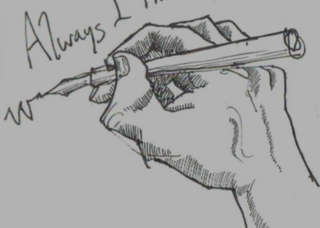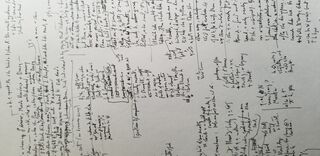Flow
The Creative Benefits of Writing Longhand
It can enhance analysis and recall, and–maybe–boost creative flow
Posted May 30, 2022 Reviewed by Hara Estroff Marano
Key points
- Writing longhand can boost analysis and recall.
- Using pen and ink may also boost creative flow.
- The creative process is independent of which hemisphere is used.

I'm a writer, and to generate words I care about I first write them longhand, with pen and ink on paper. I'm also a teacher of creative writing, and when I tell my students—virtually all of whom write everything, from lecture notes to short stories to grocery lists, on their laptops or smartphones—that I have written 20 novels, three non-fiction books, and countless essays and poems using this historic, analog method of putting down words, they react in two ways: Either they gape in astonished pity at my idiocy and possible insanity (most of them) or they consider the (farfetched) possibility that I might have access to ancient mystical wisdom that involves rejecting convenience, speed, and accuracy in favor of an arcane technique they associate with horse-drawn carriages, outdoor toilets, and the absence of wifi.
In fact I do not at all oppose writing on a computer: Whatever works best to get your story out, I insist, is right for you. But there are reasons to consider switching to longhand, some of which are backed up by recent research. Of that, more later.
My own problem with writing stuff you care about on a computer is twofold. First, it looks too good—the letters are neat and legible, the paragraphs perfectly rectangular, and my brain instinctively reacts by thinking the sentences themselves must be neat and perfect as well. Whereas when I write a sentence longhand in a scrawl that looks like a miniature cockroach took three tabs of LSD, soaked its legs in black ink, and stumbled across the page, hallucinating all the while, I am looking at something as ugly and inconsistent as my first draft most likely is—and I work hard to improve it.

The second reason I prefer longhand is that, because I write small and tight, I can cross out a phrase I dislike and write five others that might work better on every side. Another side-benefit of this process is, when I decide that the first phrase in the end sang better than the others, I can still read what I crossed out and put a check mark there to resuscitate its language.
A student once made what seemed to me a valid criticism, in reference to a point I pound upon while teaching that what drives a story is character, and what drives a character is emotion. If emotions are mostly centered (for right-handed people, ie., 95 percent of humans) in the right hemisphere, she said, but we use only our left hemisphere (which controls the right hand) for writing longhand, would this not imply that writing with pen and paper, and thus with the left hemisphere, afford less access to our emotions? And would this not, therefore, inhibit our ability to instill characters with similar emotions? Would not typing with both hands, on screen or keyboard, allow both hemispheres a chance to express themselves?
I had to admit she might have a point; although I also thought that, of the many writers I admire who created complex emotions for their characters, many wrote before keyboards and screens were invented–and surely they were not all left-handed? And in any case, with lefties, aren't the hemispheric functions reversed?
I started looking—via the internet and a computer keyboard—for answers. I found evidence, in an article by Nielsen, Zielinski et al., that the popular concept of creative right brain vs. analytical left was at best simplistic and at worst erroneous. Or in scientific terms, "Lateralization of brain connections appears to be a local rather than global property of brain networks, and our data are not consistent with a whole-brain phenotype of greater 'left-brained' or greater 'right-brained' network strength across individuals."
I also found research by neurologist Alice Flaherty demonstrating (this tends to be the case with brain research) that creative flow, like most complex neurological functions, is not restricted to any easily defined area in our heads. "Creative drive's links to better understood systems, such as the drive to communicate, provide both direct and indirect evidence for a three-factor anatomical model of creative drive coordinating frontal, temporal, and limbic systems," Flaherty wrote, adding politely that these deep, back and forth exchange patterns needed to be contrasted with older "hemispheric models" of creativity.
Other research indicates that a different kind of longhand—taking notes—has benefits compared to doing so on a laptop. When writing, more slowly, with pen or pencil, the researchers found, subjects were forced to both think about and condense what they were observing, with the result that they were better able to recall what they had thought about and taken down. When typing—much faster and more neatly—on a laptop, they tended to reproduce what they heard verbatim and without analysis. It appeared to be the analysis function that allowed easier comprehension and recall.
Introspection offers only a tenuous link between the analysis function inherent in longhand and benefits it might confer on creative writing. Certainly using my own scrawled shorthand allows me to focus on the key action or process I am trying to describe, whereas in typing I spend more time making sure the paragraphs stay perfect and ready for printing. And, as noted, the ease of editing, correcting, and re-correcting by hand makes the process of creation smoother, for me at least.
Ultimately, though, my primary advice for writers holds true: Use whatever works for you. If a character or story can entertain and move the reader, then the tools you used were both irrelevant and right.




